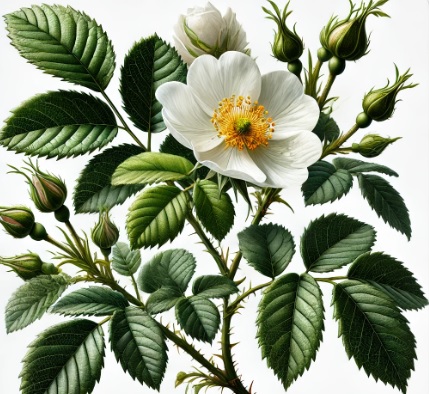Rosa laevigata, commonly known as the Cherokee rose, is a species of rose native to the southeastern United States and parts of China. This plant is distinguished by its vigorous growth and distinctive, fragrant white flowers with golden-yellow stamens. The Cherokee rose is known for its resilience and adaptability, making it a popular choice for both ornamental and practical uses in landscapes.
Botanical Classification:
Kingdom: Plantae
Order: Rosales
Family: Rosaceae
Genus: Rosa
Species: Rosa laevigata
Plant Characteristics:
Rosa laevigata is characterized by:
Medium to large white flowers with prominent golden-yellow stamens, blooming in clusters
Glossy, dark green foliage that provides a striking contrast to the white flowers
A vigorous, climbing or sprawling growth habit, which can cover trellises, fences, and other structures
Adaptability to a range of soil types and growing conditions, thriving in full sun to partial shade
Chemical Composition and Structure:
The chemical composition of Rosa laevigata includes:
Essential oils with aromatic compounds such as citronellol, geraniol, and eugenol, contributing to its subtle fragrance
Flavonoids and tannins in the petals and leaves, which offer antioxidant and astringent properties
Anthocyanins and other phenolic compounds present in the plant, contributing to its color and providing additional health benefits
Uses and Benefits:
Aesthetic: Highly valued for its ornamental qualities, including its fragrant white blooms and dense foliage, making it suitable for covering structures in gardens and landscapes.
Cosmetic: Extracts are used in skincare products and perfumes for their hydrating and aromatic properties.
Medicinal: Traditionally used for its soothing and astringent properties, although scientific research on its medicinal benefits is limited.
Culinary: The petals can be used in culinary applications, including infusions and flavoring for various dishes.
Applications:
Gardening: Popular as a climbing or sprawling plant for trellises, fences, and arbors, enhancing garden aesthetics with its prolific flowering.
Cosmetics: Extracts are incorporated into lotions, creams, and perfumes for their beneficial properties and pleasant scent.
Culinary: Fresh or dried petals used to flavor beverages and culinary dishes.
Environmental and Safety Considerations:
Environmental Impact: Non-invasive and adaptable to a variety of soil types; supports biodiversity by attracting pollinators.
Safety: Generally safe to handle; however, as with all plants, it is advisable to be cautious of potential allergic reactions in sensitive individuals.
INCI:
Skin conditioning agent. It is the mainstay of topical skin treatment as it has the function of restoring, increasing or improving skin tolerance to external factors, including melanocyte tolerance. The most important function of the conditioning agent is to prevent skin dehydration, but the subject is rather complex and involves emollients and humectants that can be added in the formulation.
Synonyms:
CAS:
![]() Rosa Laevigata
Rosa Laevigata 

